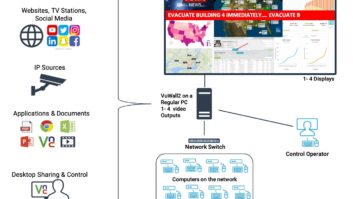TWICE:How are installers responding to the market’s challenges?
Henderson: Smart and ambitious installation firms are certainly more proactively engaging in outreach sales efforts. For some time, the referral business was strong enough to keep new business rolling in for many dealers. The slowdown has changed that. Gaining new business in this economy takes more effort and diversification. In our view, it also requires a return to the core virtues that separate true specialists from the mass marketers who are pressing into this space—a focus on quality and performance is key. One of the best differentiators is always going to be the quality of the audio experience. Demonstration is more important than ever. Many dealers are hosting open house-type events focused on music. People are listening to music now more than ever; it’s always been and always will be an essential human need. The best products elevate this experience to the sublime.
Baldwin: Diversification and differentiation is key to success in a down market. Those electronic systems contractors who offer services to a wider audience will be more likely to survive the downturn. Those companies who are actively participating in market development right now will be poised for immense growth in 2009 and beyond.
This downturn is temporary. Our economy will recover, and the demand for consumer technologies will explode in the next five years. One thing I would suggest to any ESC is to begin an outreach campaign to Realtors. With all of the inventory available, homebuyers are more likely to buy inventory [existing homes] than begin new construction. They have immediate needs, reducing the project time frame (creating “blue bird” sales). In other words, increase your retrofit business.
Starkey: We have seen the highest attrition rate since our beginning in 1989. And, yes all dealers out there are re-examining their mission and going after what limited opportunities there are.
Hench: CI dealers are cutting costs wherever they can, including moving to less expensive facilities and laying-off employees. Some have gone out of business. Many have taken on lower-priced jobs than they previously would have considered. Some are looking at complementary businesses such as lighting control to diversify and taking a more aggressive approach to finding new customers and re-visiting old ones.
Detmer: Installers are finding success by applying value-added selling techniques that involve limited discounting. This preserves their profit dollars and shows differentiation from their competitors in order to take market share. I recently heard of an installer gaining a job that was $200,000 above his competitor by showing that he had the processes, products and personnel to accomplish the job on time and without hassle. I have also heard of some installers picking up light commercial work to supplement the drop in residential business.
Soumbasakis: Dealers are adjusting their business models in a number of ways to deal with the housing downturn. More focus has been put on retrofit opportunities. These are largely enhancements to existing customers’ systems. Dealers are looking at new A/V product categories to help increase the size of the deals they land. There also seems to be more focus on the commercial installation opportunities.
Supran: At Sonance, we have been encouraging our dealers to reach out to the design community of architects and interior designers for several years now. While several progressive integrators are already focused on this opportunity, we have seen many others find success in embracing designers and architects in this down market. Many have joined their local chapters of AIA and ASID and have established relationships with top designers, bringing them into projects much earlier than they typically had been. We have also seen many residential installers taking on commercial projects. These are often small-scale, high-end projects like boutique retail, hospitality, restaurants, bars, and doctors’ offices.
Baron: The most successful integrators in this environment are getting more aggressive in retrofit, remodeling and light commercial arenas. They are not passively waiting for referrals but mining prospects from opened building permits and existing housing sales. They know that these major construction decisions result in a surge in CE product sales.
Many integrators are developing relationships with realtors, architects, remodelers and other associated trades so they become embedded in the entire community surrounding home ownership. This will reap benefits long into the future.
Another angle is that many are adding a “green” angle to their proposals. Home automation is no longer just a convenience. Lighting control and HVAC have an impact on monthly utility costs and help consumers feel better about their purchase.
Porritt: Everyone is targeting the retrofit and remodeling markets; with such an excess of inventory, retrofit is the only logical direction. MDUs continue to present an opportunity, but the market is steadily softening, so many installers are wisely turning to commercial projects, like hospitality, worship and even medical facilities.
Even bigger, at least in my opinion, are the opportunities in urban centers, provided the products conform to smaller living spaces. The market has to accept that simply focusing on traditional stand-alone homes is a surefire way to fall behind.
TWICE:How have suppliers responded to the challenging market?
Henderson: This market has been tough for many suppliers, and we fully expect there will be failures. For some time, there has been too much redundant product. As the market contracts, there will simply be no place for many suppliers to sell their products.
Many brands have responded by widening their distribution, including adding on-line sales channels. We believe this will only further dilute their position, but it’s down to survival, and brands will have to do what they can to bring revenue in.
We are staying disciplined, maintaining our limited-distribution stance. We have introduced a number of important custom-focused products targeted at upselling. If dealers are doing fewer overall jobs, and they typically are, then they need to maximize the return on the ones they are doing. To do this with credibility, you need to be able to offer demonstrably better products and get clients excited about spending more money.
Starkey: I think each manufacturing is responding based on their position. For us, it has been offering programs for dealers to support all three of our brands in the AV control, home theater and home automation space. Increasing their margins and giving them a better concept to sell has been our focus.
Hench: Several suppliers are lowering their accounts payable exposure by reducing terms and credit lines; many are reducing inventories to cut carrying costs. Some have eased minimum order requirements to make it easier for dealers to purchase. We’ve also seen price reductions, quantity discounts, discounts on bundled products, etc.
Detmer: Weak suppliers that lack the wherewithal to provide a complete and up-to-date assortment of products that they can deliver just-in-time have struggled and are collapsing. Because they have little or no core technologies or engineering capabilities, they are resorting to discounting what they have in order to drive their volumes. However, the discounts decrease their margins and raise their break-even points. So they are also forced to cut overhead just to stay in business. These guys will be gone before this is all over.
Soumbasakis: Many suppliers have taken steps to align their overhead with the levels required to support decreased sales. We have not seen price compression used as a strategy as of yet. Suppliers are also developing products that are easier to retrofit.
Supran: Vendors who thrived with a “same-for-less” approach when the housing market boomed are finding it tough in this down housing market. Dealers are looking for ways to separate themselves from their competition and sell more into each project. Vendors who provide dealers with premium-priced, high-margin solutions that dealers can provide to their clients at higher price points are better equipped to succeed in a challenging economic environment.
Baron: Although it’s tempting to cut prices, it’s more productive to provide distribution with the best tools to keep their business afloat. In our case, this means more solution-based products that appeal to end-users and fewer me-too line extensions.
The last thing integrators need is another 6 ½-inch ceiling speaker. That’s why we introduced the SurroundBar 360 DVD Theater and will soon deliver the Atrium outdoor sub/sat system. These and other consumer-driven products are becoming a bigger part of the mix.
Porritt: At Russound, we’re committed to offering a wide range of products that suit every possible scenario and income level. I’d love to see this approach adopted by everyone, competition included. We have a value-packed selection of products that cater to newcomers, and high performance, technologically advanced systems for consumers who can afford the best.
It’s most important to differentiate products from the rest of the pack. We’re doing it with Collage, and I know other companies have a few unique ideas of their own. It’s the best way to maintain interest in the CI category. Also, you have to give credit to Apple for giving us the iPod. Who would have thought that a pocket-size portable player would suddenly become the epicenter of consumers’ listening habits? But there it is, and we’re doing quite well with all our iBridge products that cater to this continually growing market segment.
Just as the iPod has become an important source component, I think we’ll see streaming services like SHOUTcast and Rhapsody continue to grow as consumers embrace the notion of having nearly every available recording as close as the nearest keypad.
TWICE:How have builders responded to the challenging market?
Henderson: We don’t do business with builders directly, but I hear there is a greater tendency to reduce prices by eliminating options, so this likely has an effect on custom systems. Where integrators have developed a relationship with a builder, there is a much greater likelihood that the builder sees the positive differentiation of offering custom systems. Certainly, a growing percentage of their clients want custom products in their new home.
Baldwin: I have presented educational courses at the NAHB Custom Builders Symposium and Sunbelt Builder’s Show over the past few months. The overwhelming response from custom builders was that the remodel market is strong. Those who are speculative builders are still moving forward but reducing the number of new starts, and they are more selective of the geographic area they build in.
Starkey: In tough times, builders tend to get more conservative, trying to deliver only that which the buyer requests. This makes selling upgrades like AV and home-wide systems more difficult unless the dealer can show the builder strong differentiation. The good news is home technology has a high profile with HDTV, expanded music sources, and now the “green” appeal.
Hench: Builders are doing whatever they can to get rid of inventory, including steep discounts and auctions. Gone though, are the easy-financing deals and “move-in with no down payment” offers of the past.
Soumbasakis: Spec-home activity has significantly declined, so loading a house with technology is not an issue. Builders will install technology if that is part of the customer’s specification.
Baron: NAHB has created a new group called the Home Technology Alliance with membership from the builder community, CE manufacturers, CEDIA, and integrators. HTA’s mission is to educate builders to the commercial benefits of adding built-in technology into new homes. The timing couldn’t be better because smart builders are looking to differentiate themselves from the mainstream and add new profit sources. And the best part is that survey after survey shows that home buyers want the types of goods and services that our industry provides.
To be specific, one of the major opportunities that NAHB has targeted for future housing growth and our industry’s growth is 50+ housing. This is a huge opportunity for home automation with a medical slant, green building to keep recurring monthly costs lower, and CE products for quality in-house entertainment. As baby boomers age, that four-bedroom monstrosity with the big lawn no longer looks as interesting, and downsizing with more amenities starts looking more and more attractive.
Porritt: From what we’ve seen, builders are more focused on moving excess inventory. Here again, manufacturers with easy-to-implement systems are in a good position to show builders how they can make existing homes more appealing by adding a multi-room system, or making it an a la carte option. Ultimately, most builders I’ve spoken with are saying they are getting back to the basics, meaning a strong, effective sales program that emphasizes value and quality-of-life benefits.
TWICE:How have reps, distributors, and rep/distributors responded to the challenging environment?
Henderson: We use a direct-salesforce model. As a former rep principal, however, I know that the business model is challenged to add value to the process wherever possible. Training, communication, in-field support are all requirements. Focusing on fewer, stronger brands is the right approach.
Baldwin: Manufacturer reps and manufacturers alike need to begin working with their dealers on real market development, such as educating industry partners on the technologies available, features and benefits, design considerations, and the importance of hiring a qualified Electronic Systems Contractor. Simply calling on dealers to discuss new products and programs is not enough in this current economic climate. Purchase orders will only increase if the demand for the amenities increases. As an industry, we need to work together, not just to get through this slowdown, but to position the ESC as a core component of the building industry moving forward.
Starkey: The best rep firms and distributors get more aggressive in times that require better responsiveness, more attention to the business, and higher operating efficiencies. Also, with fewer dealers in the market, fewer emerging lines, and reduced income, most rep firms are focusing on the lines that are at critical mass or have momentum in their favor.
Hench: As sales and commissions have dropped, some reps have gone out of business or cut back severely. Many distributors have lowered inventory levels and have tightened open-account terms. On the other hand, some distributors have aggressively targeted new dealers and taken on more lines to try to make up some of the shortfall.
Detmer: Our reps have responded by focusing their activities on the vendors they count on the most and even eliminating some vendors from their mix. They have reorganized their sales roles and responsibilities to include more technical support of dealers in an effort to add value and capture more wallet share.
Soumbasakis: Reps are definitely out there turning over rocks to find new opportunities. Many seem to be challenged in maintaining pre-downturn staff levels.
Supran: Smart reps are realizing that the days of delivering a catalog and waiting for orders to come in are over. These days, a rep firm needs to partner with their dealers and help create more demand for the lines they represent with architects, designers, builders and developers. Reps that make this investment in market development solidify their partnership with both dealers and their vendors.









